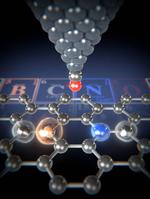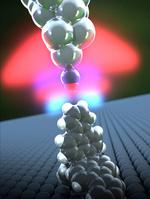Other

“For the first time, researchers have succeeded in creating strong coupling between quantum systems over a greater distance. They accomplished this with a novel method in which a laser loop connects the systems, enabling nearly lossless exchange of information and …

“Researchers have succeeded in creating an efficient quantum-mechanical light-matter interface using a microscopic cavity. Within this cavity, a single photon is emitted and absorbed up to 10 times by an artificial atom. This opens up new prospects for quantum technology …
“In power electronics, semiconductors are based on the element silicon – but the energy efficiency of silicon carbide would be much higher. Physicists of the University of Basel, the Paul Scherrer Institute and ABB explain what exactly is preventing the use …

“Physicists at the University of Basel are able to show for the first time how a single electron looks in an artificial atom. A newly developed method enables them to show the probability of an electron being present in a …

“Researchers from the University of Basel have reported a new method that allows the physical state of just a few atoms or molecules within a network to be controlled. It is based on the spontaneous self-organization of molecules into extensive …

“Today, the European Commission launched its flagship initiative on quantum technologies. Three research groups from the Department of Physics at the University of Basel are involved. The aim of the 1 billion euro research and technology funding program is to …

“ For the first time, researchers were able to study quantum interference in a three-level quantum system and thereby control the behavior of individual electron spins. To this end, they used a novel nanostructure, in which a quantum system is integrated …

“Electrical circuits are constantly being scaled down and extended with specific functions. A new method now allows electrical contact to be established with simple molecules on a conventional silicon chip. The technique promises to bring advances in sensor technology and …

“A team including physicists from the University of Basel has succeeded in using atomic force microscopy to clearly obtain images of individual impurity atoms in graphene ribbons. Thanks to the forces measured in the graphene’s two-dimensional carbon lattice, they …

“Physicists have developed a new technique that uses electrical voltages to control the electron spin on a chip. The newly-developed method provides protection from spin decay, meaning that the contained information can be maintained and transmitted over comparatively large distances …

“Scientists have developed a new method of characterizing graphene’s properties without applying disruptive electrical contacts, allowing them to investigate both the resistance and quantum capacitance of graphene and other two-dimensional materials. Researchers from the Swiss Nanoscience Institute and the …

“For the first time, scientists have succeeded in studying the strength of hydrogen bonds in a single molecule using an atomic force microscope. Researchers from the University of Basel’s Swiss Nanoscience Institute network have reported the results in the …
